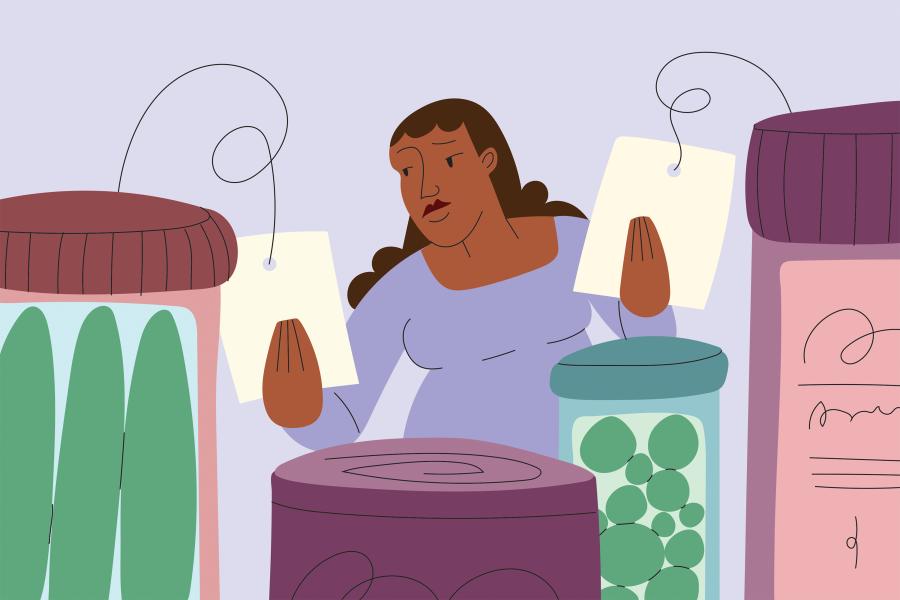When Laura Samuel talks about food insecurity, she often draws upon her own experiences spending part of her youth in a mobile home in coastal Maine, one of six children in a hardworking family that often faced tough choices regarding money. Despite these challenges, her parents never failed to provide food for their kids.
"We all knew there were certain things we couldn't afford, but my parents always made sure there was food on the table," she recalls. "Sometimes it might not have been the food we wanted, or the most balanced of meals, but we were never hungry. Still, those experiences planted a seed in my head [that] financial strain can affect people's lives and well-being."
It isn't surprising then that Samuel, an assistant professor in the School of Nursing, aims her research lens at economic and racial disparities and their effects on public health, aging, disabilities, and chronic care. One singular focus has been on food insecurity and the impact of the Supplemental Nutrition Assistance Program, or SNAP, formerly known as the Food Stamp Program.
"As a nurse, you can't improve people's health if they don't have food to eat," she says. "It's a fundamental health issue."
Poor nutrition raises the risk of developing numerous health problems, such as obesity, high blood pressure, type 2 diabetes, metabolic syndrome, and certain types of cancers. "Not having enough nutritious food will make an impact on your health over the long term, with higher rates of chronic conditions, disability, and earlier death," she says.
Food insecurity, Samuel explains, is defined as not having consistent access to food because of social or economic conditions. "It's often about money, but it also can be more complex than that," she adds. Lack of transportation and access to grocery stores are two causes; aging is another. "Older adults need someone to help them purchase or prepare food," Samuel says.
A better understanding of these barriers to food access "drove me to want to do this type of research."
Her most recent study, published in June in JAMA Network Open, examined the influence of SNAP on racial disparities and food insecurity. She and her fellow researchers analyzed national data that the Census Bureau collects through the Survey of Income and Program Participation, which tracks income levels and SNAP use. They focused on a sample of 4,974 households divided into specific categories—entirely white, entirely Black, entirely Asian, as well as multiracial families—and looked within each to identify disparities in food insecurity. She found that the program made a big difference in closing the race-based food insecurity gap.
"We found that households that were Black were more likely to be food insecure than those of whites—but that this pattern only existed among those who didn't use SNAP."
The results come during a time of political backlash against the program, largely from Republicans on Capitol Hill who forced stricter work requirements for SNAP recipients as a part of the deal to raise the debt ceiling. At the same time, pandemic-related emergency expansion of SNAP benefits came to an end, further tightening access.
It can be difficult for low-income individuals to qualify for SNAP. Most adults age 18-49 without children in their homes qualify for benefits for only three months during a three-year period, unless they can prove they are working or are in a job training program for 20 hours a week or if they have an exemption, such as a disability.
The debt ceiling agreement expands the work requirement in increments over time to age 54.
"SNAP already can be difficult to access for many people, as the enrollment process can be cumbersome and there are a number of existing requirements that limit the program for people who might otherwise be eligible," Samuel says. "That means low-income people often don't bother enrolling. The debt agreement bumped up the age, and many people—if they can't find work—can't meet that requirement, especially if they have a disability."
To qualify for a disability exemption, "you have to receive disability benefits, which, by itself, is an onerous process," she says. "So, this not only raises the age but ignores the fact that many people struggle to find work."
Samuel's previous SNAP studies have found that the supplemental food benefits have positive effects on a range of scenarios but can be difficult to access. She has studied SNAP participation among families where there are disabilities and learned that participants in the program in the state of Maryland have lower admission rates to nursing homes. She's also found that a 2009 SNAP policy change that expanded benefits for income-eligible adults was associated with a drop in the upward trend of hemoglobin A1C levels—a test that can be a sign of diabetes—and a decrease in total cholesterol, a precursor to cardiovascular disease. Another of her studies found the program was linked to a drop in the use of hospitals and emergency departments by low-income older adults in Maryland.
"My overall purpose is to figure out why poor people have poorer health outcomes and what we can do about it," she says. "The SNAP program is particularly intended to improve economic well-being. We know that food is necessary to maintain health." The results of her studies into SNAP "suggest that we should take every opportunity to improve access, rather than erect more barriers that make it increasingly difficult for people to consistently eat good, nutritious food," she adds. "There is irrefutable evidence that good food means good health."
Posted in Health
Tagged welfare, food access








